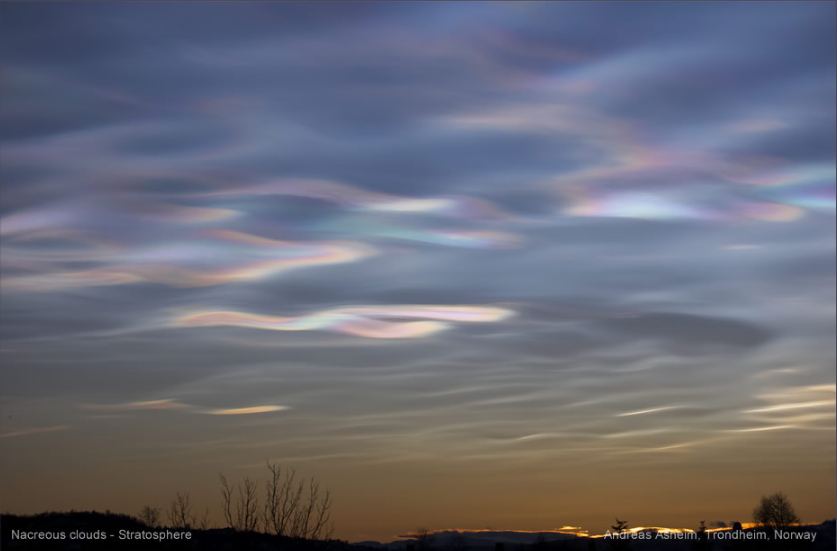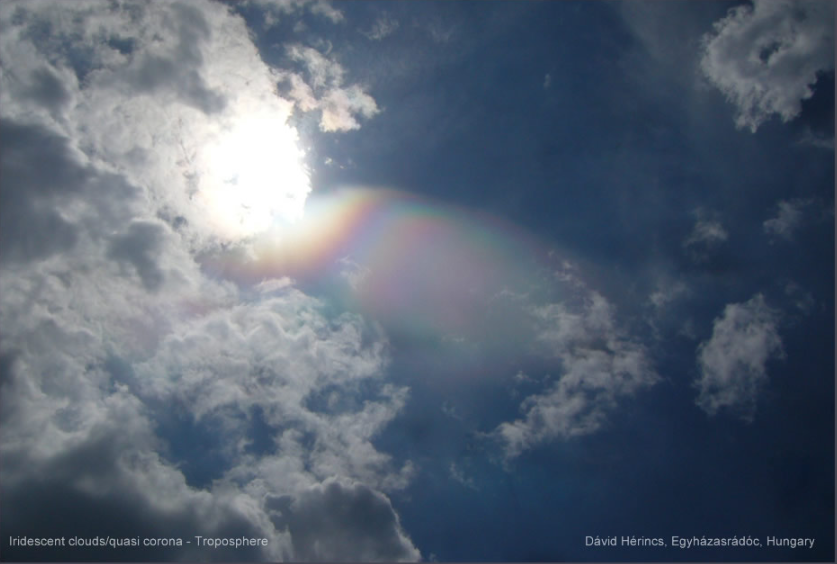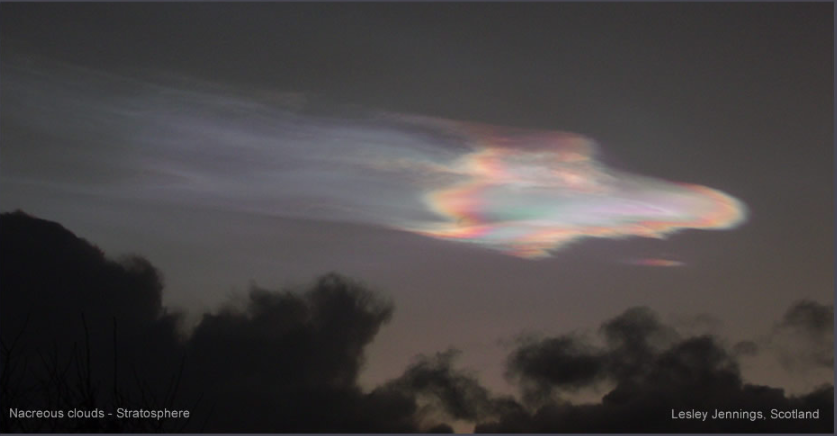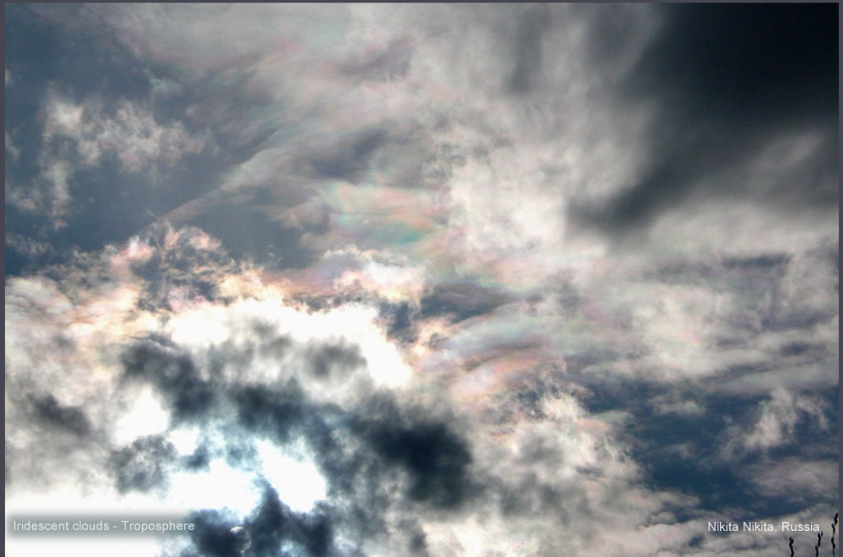OPOD - Nacreous Clouds
Nacreous Clouds: A Spectacular Atmospheric Phenomenon
Nacreous clouds, also known as polar stratospheric clouds (PSCs), are a rare and stunning sight in the sky. These unique cloud formations occur in the stratosphere, high above the Earth's surface. In this article, we will explore the characteristics of nacreous clouds and how they differ from tropospheric iridescent clouds.
Distinguishing Nacreous Clouds from Tropospheric Iridescent Clouds
To differentiate between nacreous clouds (NCs) and tropospheric iridescent clouds (TCs), several factors come into play:
-
Time: Nacreous clouds become visible after sunset and can remain in the sky for up to an hour. These clouds illuminate in the dark as sunlight from high altitudes reflects off them. On the other hand, tropospheric iridescent clouds are observed only during daytime. However, exceptionally bright nacreous clouds can sometimes resemble tropospheric clouds during the day.
-
Season: Nacreous clouds predominantly form in winter when the lower stratosphere reaches temperatures below -85 degrees Celsius. Conversely, tropospheric iridescent clouds can be observed throughout the year.
-
Weather: While stormy tropospheric weather can enhance the formation of nacreous clouds, it is not a prerequisite. The strong winds associated with storms likely help carry moisture from the troposphere into the usually dry stratosphere. Tropospheric iridescent clouds, on the other hand, can form under any weather conditions.
-
World Location: Nacreous clouds are primarily seen in regions where the stratosphere experiences extreme cold temperatures. These locations include high latitudes, Northern Europe, Scandinavia, Iceland, Greenland, Canada, and occasionally the northernmost parts of the United States. In contrast, tropospheric iridescent clouds can be observed anywhere.
-
Local Geography: Nacreous clouds are wave clouds that often appear downwind of mountains. The airflow around mountains creates favorable conditions for the formation of these unique clouds. Tropospheric iridescent clouds, including lenticular clouds, can occur in various locations but are also commonly found in the lee of mountains.
-
Movement: High-altitude nacreous clouds tend to remain nearly stationary while lower, darker clouds move swiftly beneath them. This distinct behavior sets them apart from tropospheric iridescent clouds.
Characteristics of Nacreous Clouds
Nacreous clouds exhibit several remarkable characteristics that contribute to their awe-inspiring appearance:
-
Brightness: Nacreous clouds are exceptionally bright, especially when observed during twilight. These luminous clouds stand out against the darkening sky, creating a mesmerizing spectacle.
-
Shape and Structure: Nacreous clouds often display wavy, filmy, and curling patterns that continuously change over minutes. They exhibit slowly shifting electric colors, adding to their allure. In contrast, tropospheric iridescent clouds can be wavelike but typically possess irregular or finer-grained structures.
-
Surrounding Clouds: Nacreous clouds are a type of polar stratospheric cloud (PSC) and are frequently found embedded within other PSCs of similar shape. These surrounding clouds may not exhibit the same vibrant colors as nacreous clouds but contribute to the overall atmospheric display.
-
Iridescence: Both nacreous clouds and tropospheric iridescent clouds display iridescence. In nacreous clouds, small ice crystals of similar size diffract sunlight, creating a colorful display. Tropospheric iridescent clouds, on the other hand, owe their iridescence to small water droplets or, less commonly, ice crystals acting as diffractors.
Recognizing Tropospheric Iridescent Clouds
Identifying tropospheric iridescent clouds can sometimes be challenging, particularly when they resemble nacreous clouds. However, a few key factors can help distinguish them:
-
Location: Tropospheric iridescent clouds are often observed in daylight near the sun. If the cloud is in close proximity to the sun, it is unlikely to be a nacreous cloud. Location, season, and time of observation are essential factors in making a correct identification.
-
Form and Duration: Tropospheric iridescent clouds tend to change their shape quickly rather than exhibiting the gradual transformations seen in nacreous clouds. Observing the cloud's behavior over time, especially after sunset, can help confirm its classification.
In conclusion, nacreous clouds are a captivating atmospheric phenomenon that occurs in the stratosphere during winter months in high latitude regions. Their distinctive characteristics, such as their brightness, shape, and structure, set them apart from tropospheric iridescent clouds. By understanding the factors that differentiate these cloud types, observers can appreciate the unique beauty and rarity of nacreous clouds when they grace the sky.

Nacreous or Tropospheric?
A collection of rare stratospheric nacreous clouds and not so rare tropospheric iridescent clouds from Norway, Poland, Hungary, Scotland and Russia.
How are nacreous clouds (NCs) distinguished from tropospherics (TCs)?
Time: Nacreous clouds brighten after sunset and can remain visible for an hour. They glow in the dark as high altitude sunlight lights up the 9-16 mile high NCs. TCs are seen only in daytime. Very bright NCs can look like TCs in the day.

Season: NCs form in winter. TCs all year round. The ice crystals of NCs only form when the lower stratosphere cools below -85 Celsius.
Weather: Stormy tropospheric weather can favour NCs although it is not essential. The winds probably help loft necessary moisture across the tropopause into the otherwise very dry stratosphere. TCs any weather.
World Location: NCs are only seen where the stratosphere is cold � high latitudes, Northern Europe, Scandinavia, Iceland, Greenland, Canada and sometimes northernmost US. TCs anywhere.

Local geography: NCs are wave clouds. Downwind of mountains are favourable spots. TCs anywhere but iridescent lenticular clouds also occur in the lee of mountains.
Movement: High NCs stay almost in the same position while dark lower clouds scud beneath them.
Brightness: NCs are very bright indeed - shining in the twilight sky.
Shape & structure: NCs wavy, filmy, curling and uncurling over minutes with slowly changing electric colours. TCs can be wavelike but more often are irregular or have a finer grained structure.
Surrounding clouds: NCs are a type of Polar Stratospheric Cloud (PSC) and are often embedded in other less colourful PSCs of similar shape.
Both NCs and TCs are iridescent. In NCs small similar sized ice crystals diffract sunlight. In TCs the diffractors are small water droplets or, less often, ice crystals.

The ribbed cloud structure gives these away as tropospheric iridescent clouds. Plus they are in daylight near the sun

This could be mistaken for a nacreous cloud but it is far too near the sun and probably changed its form quickly rather than slowly over many minutes.

A classic nacreous cloud glowing in the twilit sky. Trailing from it are less iridescent Type I Polar Stratospheric Clouds.
Dark tropospheric clouds hurry beneath.

Not easy. Filmy in appearance.
In daylight near the sun and probably iridescent cirrus. Location, season and time usually helps decide. If not, follow them until after sunset - if they fade they are tropospheric.
Note: this article has been automatically converted from the old site and may not appear as intended. You can find the original article here.
Reference Atmospheric Optics
If you use any of the definitions, information, or data presented on Atmospheric Optics, please copy the link or reference below to properly credit us as the reference source. Thank you!
-
<a href="https://atoptics.co.uk/blog/opod-nacreous-clouds/">OPOD - Nacreous Clouds</a>
-
"OPOD - Nacreous Clouds". Atmospheric Optics. Accessed on November 26, 2024. https://atoptics.co.uk/blog/opod-nacreous-clouds/.
-
"OPOD - Nacreous Clouds". Atmospheric Optics, https://atoptics.co.uk/blog/opod-nacreous-clouds/. Accessed 26 November, 2024
-
OPOD - Nacreous Clouds. Atmospheric Optics. Retrieved from https://atoptics.co.uk/blog/opod-nacreous-clouds/.